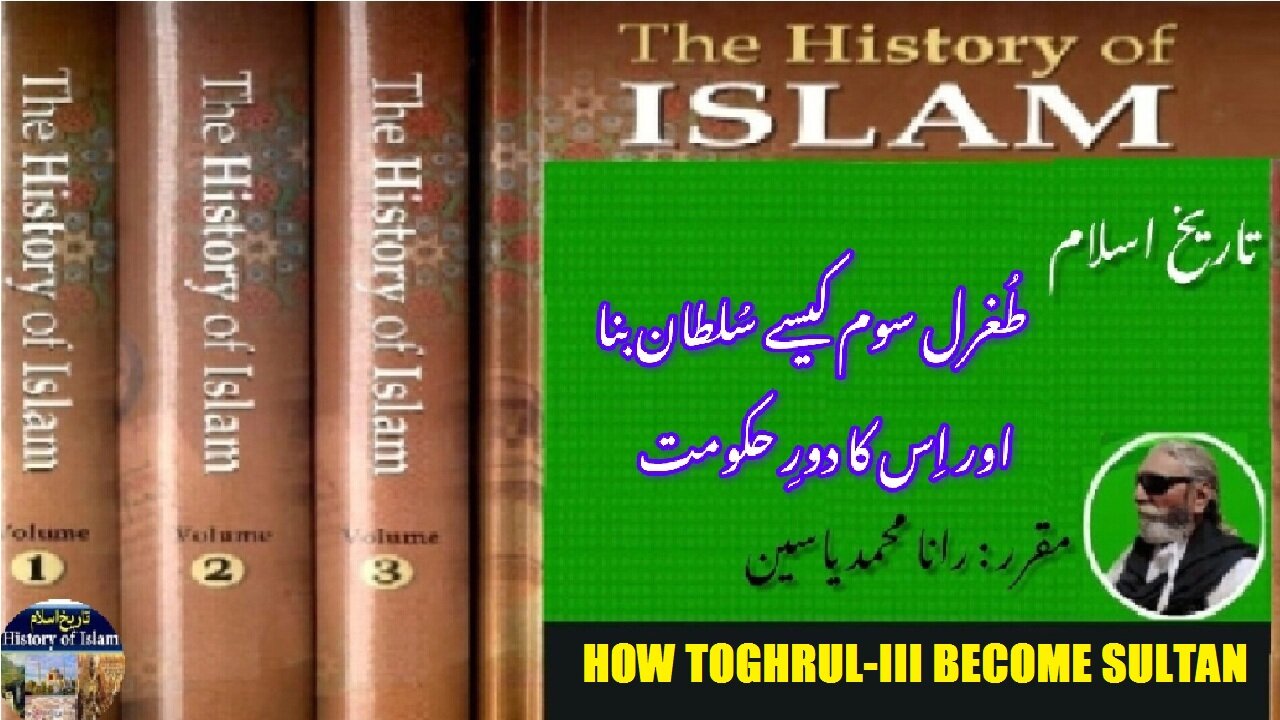Premium Only Content

How Toghrul-III was become Sultan, and his Reign | طغرل سوم کیسے سلطان بنا اور اس کا دور حکومت
@islamichistory813 #HistoricalAnalysis #ToghrulIII #SultanateLegacy #ToghrulIII #become #Sultan #Reign
How Toghrul-III was become Sultan, and his Reign.
Dekhti Aankhooon aur sountay kaanoon ko Asslamoalaikum, sisters, brothers friends and elders, In this Islamic informative video, we presenting that how Toghrul-III to become Sultan of the Sultanate and the pivotal moments of his reign. Through a analysis, we will highlight the challenges he faced, the alliances he forged, and the contributions he made to his empire. Watch complete video and get to know the historical significance of Toghrul-III's rule and its lasting effects on subsequent generations.
Toghrul III was seven years old when he began his reign, he was well treated by Jahan Pahlvan, who remained the effective ruler of the empire, with his brother Muzzafar Al-Din Qizil Arslan Uthman as his chief subordinate in Tabriz, who was also Atabeg of Nusrat al-Din Abu Bakr, one of the sons of Jahan Pahlvan. Jahan Pahlvan managed to stop the invasion of Saladin, who had advanced as far as Lake Van, but turned back when news arrived that Seyfettin Beytemür, ruler of Akhlat had accepted the suzerainty of Muhammad Jahan Pahlavan. Problems cropped up after Jahan Pahlavan died in 1186, as he had appointed his four sons as governors, Abu Bakr ruled Azerbaijan and Arran, Ozbeg was appointed to rule Hamadan, sons of the daughter of Ïnanch Sonqur, Qutlugh Inanch Muhammad and Amir Amiran Umar ruled Rey, Isphahan and parts of Western Persia under the supervision of their uncle Qizil Arslan. They had sworn to obey Qizil Arslan and never to rebel against Toghrul III. When Jahan Pahlvan died, Qizil Arslan assumed his position, which was contested by his brother's widow, Innach Khatun, who wanted her son Qutlugh Inanch Muhammad to succeed his father, as she was afraid the childless Qizil Arslan would nominate his favorite Abu Bakr as his heir, Toghrul III, who resented the harsh treatment he received from Qizil Arslan, joined the rebels. This conflict possibly prevented Toghrul III and Qizil Arslan from aiding Muhammad b. Bahram Shah, the last Seljuk Sultan of Kirman, who had been driven from Kirman by Oghuz rebels driven out from Khurasan in 1186.
The rebel army consisted of the forces of the Amirs of Zenjan and Maragha, the retainers of both Kamal Ai-Aba, head of the Mamluks, and of Saif al-Din Rus, husband of Innach Khatun, while Toghrul himself received significant support from Turkmens, and their combined army forced Qizil Arslan to leave Hamadan after some clashes. Toghrul undertook two diplomatic ventures in 1187, he journeyed to Mazandaran to request aid from Bavandid Husam al-Daula Ardashir, and received troops from him, and Toghrul also sent messages to Caliph Al-Nasir, asking him to restore the palace of the Seljuk Sultan in Baghdad for him, but the Caliph razed the palace and then sent aid to Qizil Arslan, who agreed to become the Caliph's vassal. The Caliph sent an army numbering 15,000 under his vizier Jalal al-Din 'Ubaidallah b. Yunus, which attacked Hamadan in 1188 without waiting for Qizil Arslan's army to arrive, he was defeated and captured, Toghrul secured victory by charging the enemy center after his right wing was battered, but this was a Pyrrhic victory, as Toghrul's army suffered grievous losses in the battle. The Sultan next tried to reform his administration and coordinate strategy with available resources, but his rash behavior regarding a dispute over the command of the army, led to the execution of Kamal Ai-Aba, Saifuddin Rus and several of the Sultan's opponents, and the desertion of his allies.
Qizil Arslan had declared Sanjar b. Suleiman-Shah as the Seljuk Sultan of Iraq, and reinforced by troops sent by the Caliph now invaded Hamadan, Toghrul, unable to resist the invasion, first retreated to Isphahan, then to Urmia. He was joined by an army led by his brother in law Hasan Kipchiq, and Toghrul also tried to get help from the Ayyubids and the Caliph, even sent his infant son as hostage to Baghdad in a futile gesture. Toghrul invaded Azerbaijan and sacked the towns of Ushnu, Khoy, Urmiya and Salmas. Qizil Arslan reconciled with his nephews and defeated and captured Toghrul when he again invaded Azerbaijan in 1190. Qizli Arslan imprisoned Toghrul and his son Malik Shah in Kuhran fortress near Tabriz. Qizil Arslan, encouraged by the Caliph, soon declared himself Sultan, married Innach Khatun, his brother's widow, and was poisoned by her in September, 1191. His nephews began to rule independently, and one of the Mamluks of Jahan Pahalvan, Mahmud Anas Oglu, freed Toghrul III from his prison in May 1192.
Probable depiction of Tughril III and his court.
Toghrul eluded the pursuers sent by Abu Bakr and quickly assembled an army from his supporters and Turkmens, then marched east and defeated the army of Qutlugh Inanch Muhammad and Amir Amiran Umar near Qazvin on June 22, 1192, and won over a large part of the enemy soldiers after his victory. Qutlug-Inach and Amiran Omar then attacked Abu Bakr in Azerbaijan and was beaten, Aimiran Umar sought refuge with his father in law Shirvanshah Akhsitan-I, while Qutlug-Inach moved to Rey. Toghrul occupied Hamadan, secured the treasury and came to rule over Isphahan and Jibal, but did not attempt to negotiate an agreement with Abu Bakr, against Qutlug Innach. Qutlugh Innach now appealed to Khwarazmshah Ala ad-Din Tekish for aid, and Tekish invaded and captured Rey in 1192, forcing Qutlug Innach to flee the city.
Tomorow we will be described Truce with Shah Tekish of Sultan Toghrul-III and Battle of Rey. So permission us upto tomorow. Allah Hafiz
======================================
-
 LIVE
LIVE
Fresh and Fit
8 hours agoIsrael-Hezbollah Ceasefire & Reacting To Death Threats On X
5,266 watching -
 1:11:10
1:11:10
Steve-O's Wild Ride! Podcast
5 days ago $9.14 earnedDusty Slay Went From Selling Pesticides To Having A Netflix Special - Wild Ride #244
32.9K3 -
 1:16:02
1:16:02
CocktailsConsoles
6 hours agoBE PART OF THE GAME!!| Death Road to Canada | Cocktails & Consoles Livestream
23K1 -
 8:19:28
8:19:28
Phyxicx
8 hours agoWe're streaming again! - 11/26/2024
19.6K -
 6:49:31
6:49:31
GamingWithHemp
8 hours agoHanging with Hemp #103
38.7K3 -
 21:24
21:24
DeVory Darkins
1 day ago $10.88 earnedElon Musk and Tucker Carlson SHATTER Left Wing Media
39.2K36 -
 15:13
15:13
Stephen Gardner
5 hours ago🔥Breaking: Trump JUST DID the UNEXPECTED | Tucker Carlson WARNS America!
34.7K76 -
 1:18:01
1:18:01
Glenn Greenwald
10 hours agoWill Trump's Second Term Promote Economic Populism? Matt Stoller On Cabinet Picks To Fight Corporate Power; Should Liberals Cut Off Pro-Trump Friends & Family? | SYSTEM UPDATE #372
175K202 -
 2:26:30
2:26:30
WeAreChange
11 hours agoTrump To Subdue Deranged Opposition! ARRESTS Planned
136K59 -
 1:19:04
1:19:04
JustPearlyThings
11 hours agoWhy MODERN WOMEN Keep REJECTING The Redpill! | Pearl Daily
104K58